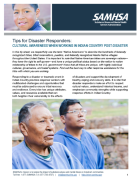This tip sheet is a revised/updated document discussing Historical trauma in Indian Country.
Dashboard: Filter Bricks
Main page content


This tip sheet is a revised/updated document discussing Cultural Awareness working post disaster in Indian Country.

This manual helps communities plan and deliver substance use prevention strategies. It covers conducting needs assessments, identifying partners, and creating effective strategies for marketing and program evaluation. The manual also offers a sample timeline of tasks. Revised 2020

The SAMHSA Spotlight Series highlights different approaches to building trauma-informed, resilient communities. This introductory issue present's SAMHSA's six principles of trauma-informed approach, and summarizes SAMHSA's community trauma initiative.

This fact sheet, developed for tribal audiences and the agencies that work with them, reviews suicide prevention in Indian Country and how the 2012 National Strategy for Suicide Prevention can apply to tribal communities.

This fact sheet provides information and resources related to the specific bullying prevention needs for American Indian and Alaska Native communities. It highlights effective school-based anti-bullying prevention strategies.

For individuals at risk of suicide, primary and behavioral health care settings provide unique opportunities to connect with the health care system and access effective treatment. Suicide Safe is a free mobile app that helps providers integrate suicide prevention strategies into their practice and address suicide risk among their patients. The Suicide Safe app is based on SAMHSA's Suicide Assessment Five-Step Evaluation and Triage (SAFE-T) card.
With Suicide Safe, primary and behavioral health care providers can:
- Learn how to use the SAFE-T approach when working with patients.
- Explore interactive sample case studies and see SAFE-T in action through case scenarios and tips.
- Quickly access and share information, including crisis lines, fact sheets, educational opportunities, and treatment resources.
- Browse conversation starters that provide sample language and tips for talking with patients who may need suicide intervention.
- Locate treatment options, filter by type and distance, and share locations and resources to provide timely referrals for patients.
For more information, email SAMHSA at samhsainfo@samhsa.hhs.gov.

This toolkit is for practitioners living with a mental illness who wish to own and operate mental health services. The toolkit provides guidance based on evidence-base practices, and includes a brochure, presentation, and introductory video.

